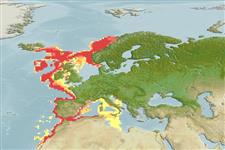Environment: milieu / climate zone / depth range / distribution range
Ecologie
marien; standvastig; diepte 100 - 1000 m (Ref. 35388). Temperate; 69°N - 24°N, 18°W - 17°E
Northeast Atlantic: found in the western Mediterranean and in the Atlantic around the Strait of Gibraltar and to the south along the Moroccan coast.
Grootte / Gewicht / Leeftijd
Maturity: Lm ? range ? - ? cm
Max length : 16.1 cm TL mannelijk / geslacht onbekend; (Ref. 128593); common length : 10.0 cm TL mannelijk / geslacht onbekend; (Ref. 1371); max. gepubliceerd gewicht: 48.98 g (Ref. 128593); max. gerapporteerde leeftijd: 3.00 Jaren (Ref. 1371)
Dorsale stekels (totaal) : 0; Anale stekels: 0. Eyes large; mouth oblique; chin barbel absent. Color varies from pink to light brown dorsally, silvery on sides and ventrally (Ref. 1371). Scales large, silvery and easily detached. Lateral line ends in 7 open mucus grooves on the upper side of the head (Ref. 35388).
Occurs in large schools over mud, muddy sand, gravel and rock bottoms. Feeds on small crustaceans and maybe worms. Preyed upon by other valuable fish (Ref. 1371). Spawns in the winter in the western Mediterranean and in the spring farther north (Ref. 35388).
Levenscyclus en paargedrag
Maturiteit | Voortplanting | Paaien | Eieren | Fecunditeit | Larven
The major spawning grounds are located in the western part of the Mediterranean, on both sides of the Straits of Gibraltar, in deep water.
Cohen, D.M., T. Inada, T. Iwamoto and N. Scialabba, 1990. FAO species catalogue. Vol. 10. Gadiform fishes of the world (Order Gadiformes). An annotated and illustrated catalogue of cods, hakes, grenadiers and other gadiform fishes known to date. FAO Fish. Synop. 125(10). Rome: FAO. 442 p. (Ref. 1371)
Status op de Rode Lijst van het IUCN (Ref. 130435: Version 2024-1)
Gevaar voor de mens
Harmless
Gebruik door de mens
Visserij: van minder commercieel belang; aas: usually
Tools
Speciale rapporten
Download XML
Internetbronnen
Estimates based on models
Preferred temperature (Ref.
123201): 3.4 - 13.9, mean 7.9 °C (based on 254 cells).
Fylogenetische diversiteitsindex (Ref.
82804): PD
50 = 0.7500 [Uniqueness, from 0.5 = low to 2.0 = high].
Bayesian length-weight: a=0.00661 (0.00553 - 0.00789), b=3.09 (3.04 - 3.14), in cm total length, based on LWR estimates for this species (Ref.
93245).
Trofisch niveau (Ref.
69278): 3.6 ±0.3 se; based on diet studies.
Generation time: 5.8 ( na - na) years. Estimated as median ln(3)/K based on 2
growth studies.
Weerstandsvermogen (Ref.
120179): Gemiddeld, minimale populatieverdubbelingstijd 1,4-4,4 jaar (K=0.19-0.50; tmax=3.0).
Fishing Vulnerability (Ref.
59153): Low to moderate vulnerability (25 of 100).
Nutrients (Ref.
124155): Calcium = 61.8 [31.4, 132.3] mg/100g; Iron = 0.524 [0.258, 1.013] mg/100g; Protein = 17.8 [16.3, 19.3] %; Omega3 = 0.96 [0.45, 2.06] g/100g; Selenium = 12.2 [5.0, 31.6] μg/100g; VitaminA = 24.4 [5.5, 106.1] μg/100g; Zinc = 0.755 [0.473, 1.180] mg/100g (wet weight);
